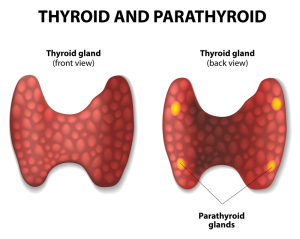Generally speaking, here I am discussing what’s new with thyroid cancer based on a few recent papers that indicate in which direction things are moving.
1. Fine needle aspirates for thyroid cancer diagnosis
In Ref. 3 the authors describe how they used an oncogene tumor marker for papillary thyroid carcinoma, which is the most common thyroid cancer. In fact, they diagnosed this thyroid cancer on minuscule sample sizes with 100% accuracy. Certainly, it seems that gene derived technology is yet another means to improve diagnostic accuracy.
2. The PET scanner
This diagnostic tool, in particular, can be a valuable to diagnose metastatic thyroid cancer, where the primary tumor is unknown. Using a fluoridated glucose compound all the thyroid cancer cells including the primary tumor light up on a PET scan test. Treatment can then be directed at the cancer site wherever it was located.
3. Disregulation of the “wild-type” P53 gene
Equally important, many thyroid cancers were found in Ref. 5 to have a disregulation of the “wild-type” P53 gene. This is associated with an increase in two proteins that are transcribed by the p53 gene, “BAX” protein and “p21” protein. These proteins can be investigated by immunohistochemistry, which is what these authors did. To their surprise they found that many benign thyroid tumors (goitres and adenomas) had a high value of these proteins, but also many thyroid cancers with a good prognosis (follicular and papillary thyroid cancers). In an earlier paper the same group had shown that patients with liver metastases from colon cancer had a poor survival, if the BAX protein, investigated with immunohistochemistry, was low or absent (Ref. 6). In summary, the authors think that tests of these proteins with immunochemistry methods might be able to predict, which patients have a better long-term survival.
4. New development with regard to anaplastic thyroid cancer
The anaplastic thyroid cancer, which has a 10-year survival of 0% , has been shown in tissue cultures to respond to two new metabolic inhibitors (Ref. 7).They belong into the group of “histone deacetylase inhibitors” (never mind the name, if this sounds foreign to you). The two agents that tested well in this category were: sodium butyrate and trichostatin A. The authors of this study describe how these agents stop the cell division of this very malignant thyroid cancer cell line in tissue culture. For this reason we likely will see several clinical trials soon to check out how these medications can help patients with this type of cancer survive longer.
5. Another cell growth inhibitor
Another cell growth inhibitor, which works on another enzyme, was shown to have a powerful effect on stunting growth of human papillary thyroid cancer in tissue culture and in mice (Ref. 8). One of the medications was troglitazone. Note that this link indicates that this medication is off the market in the US because of serious side effects; it had been used for other cancers in the past. This medication was treating hyperinsulinism; avoidance of sugar and starchy foods will achieve the same effect with no toxicity! Be very careful rushing to take any of the newer medications that are being tested now to replace troglitazone.
6. Borderline hyperthyroidism
Borderline hypothyroidism may escape being diagnosed for several years, during which the TSH blood test would be higher than 2 µIU/mL. In fact, as TSH is a potentially carcinogenic hormone, it is important to treat hypothyroidism even at these early stages. In contrast, in the past it was thought in Medical Schools that a TSH of 5 µIU/mL or less would be normal. On the other hand, at the 19th Annual World Congress Anti-Aging and Aesthetic Medicine in Las Vegas (December 8-10, 2011) Dr. Hertoghe and other speakers agreed that the new norm would be now a TSH of less than 2 µIU/mL.
High TSH can cause thyroid cancer
When people with hypothyroidism levels of 7 to 10 µIU/mL are not treated right away, there is a risk of thyroid cancer developing down the road. A word of caution though: thyroids of mice and rats are very sensitive to TSH in the sense of developing thyroid cancer relatively quickly, in man this is somewhat so, but not as established as in these animal models (one of those areas where animal models do not fit the human situation 100%).
References
1. Cancer: Principles&Practice of Oncology. 5th edition, volume 1. Edited by Vincent T. DeVita, Jr. et al. Lippincott-Raven Publ., Philadelphia,PA, 1997. Thyroid tumors.
2. Cancer: Principles &Practice of Oncology, 4th edition, by V.T. De Vita,Jr.,et. al J.B. LippincottCo.,Philadelphia, 1993.Thyroid tumors.
3. CC Cheung et al. J Clin Endocrinol Metab 2001 May;86(5):2187-2190.
4. F Dede et al. Clin Nucl Med 2001 May;26(5):396-399.
5. S Hermann et al. Int J Cancer 2001 Jun 15;92(6):805-811.
6. I Sturm et al. J Clin Oncol 1999 May;17(5):1364-1374.
7. VL Greenberg et al. Thyroid 2001 Apr;11(4):315-325.
8. K Ohta et al. J Clin Endocrinol Metab 2001May;86(5):2170-2177.
9. Conn’s Current Therapy 2004, 56th ed., Copyright © 2004 Elsevier
10. Ferri: Ferri’s Clinical Advisor: Instant Diagnosis and Treatment, 2004 ed., Copyright © 2004 Mosby, Inc







